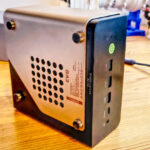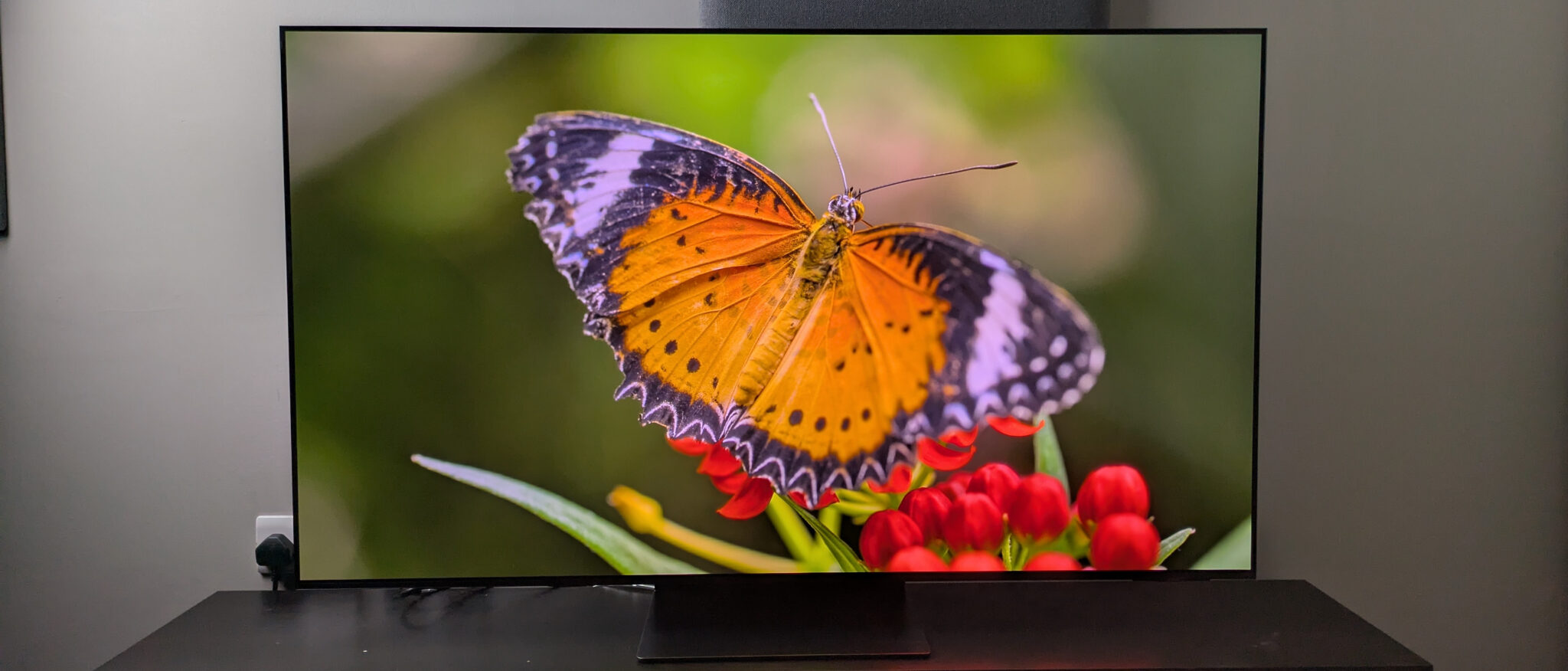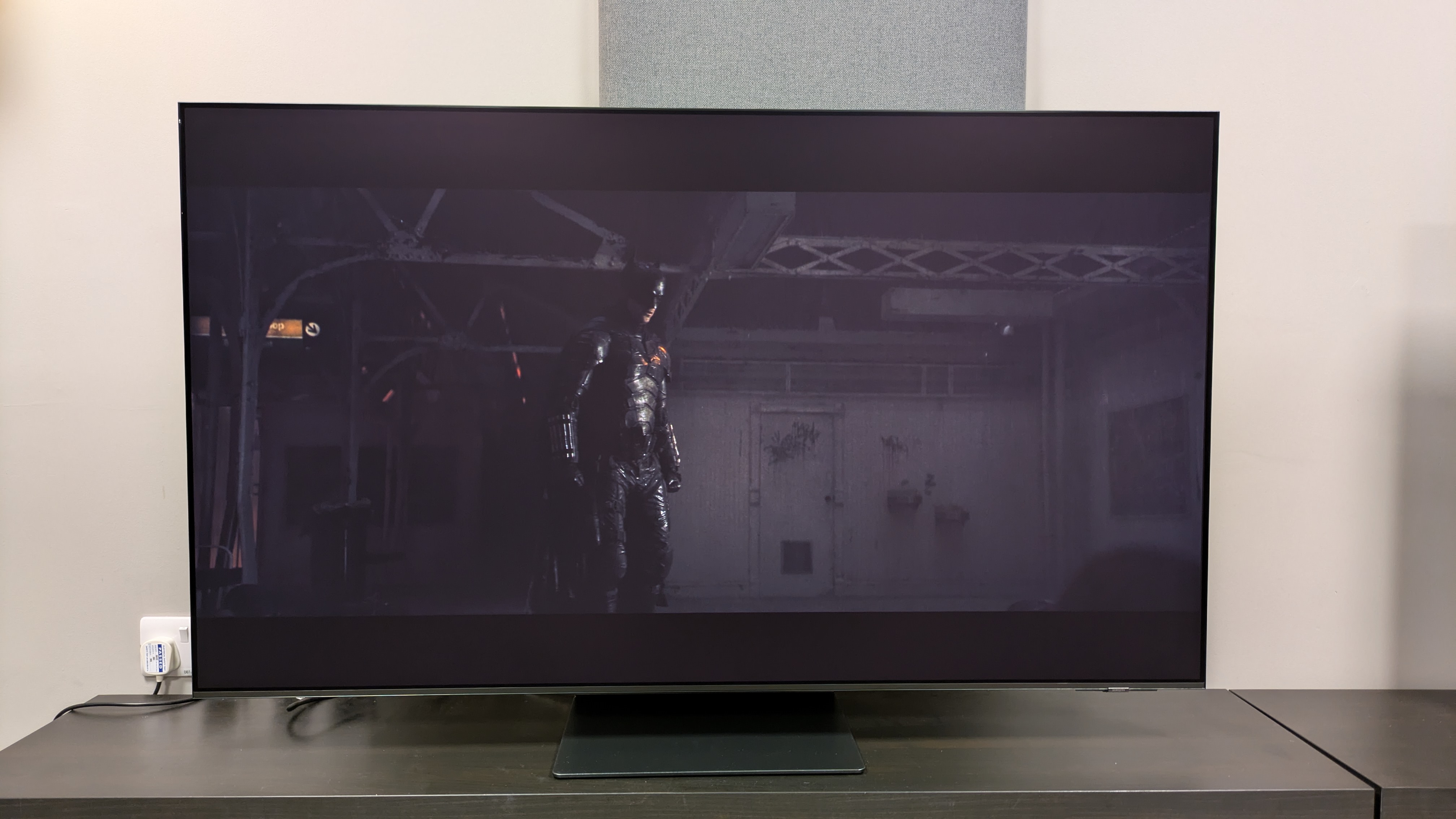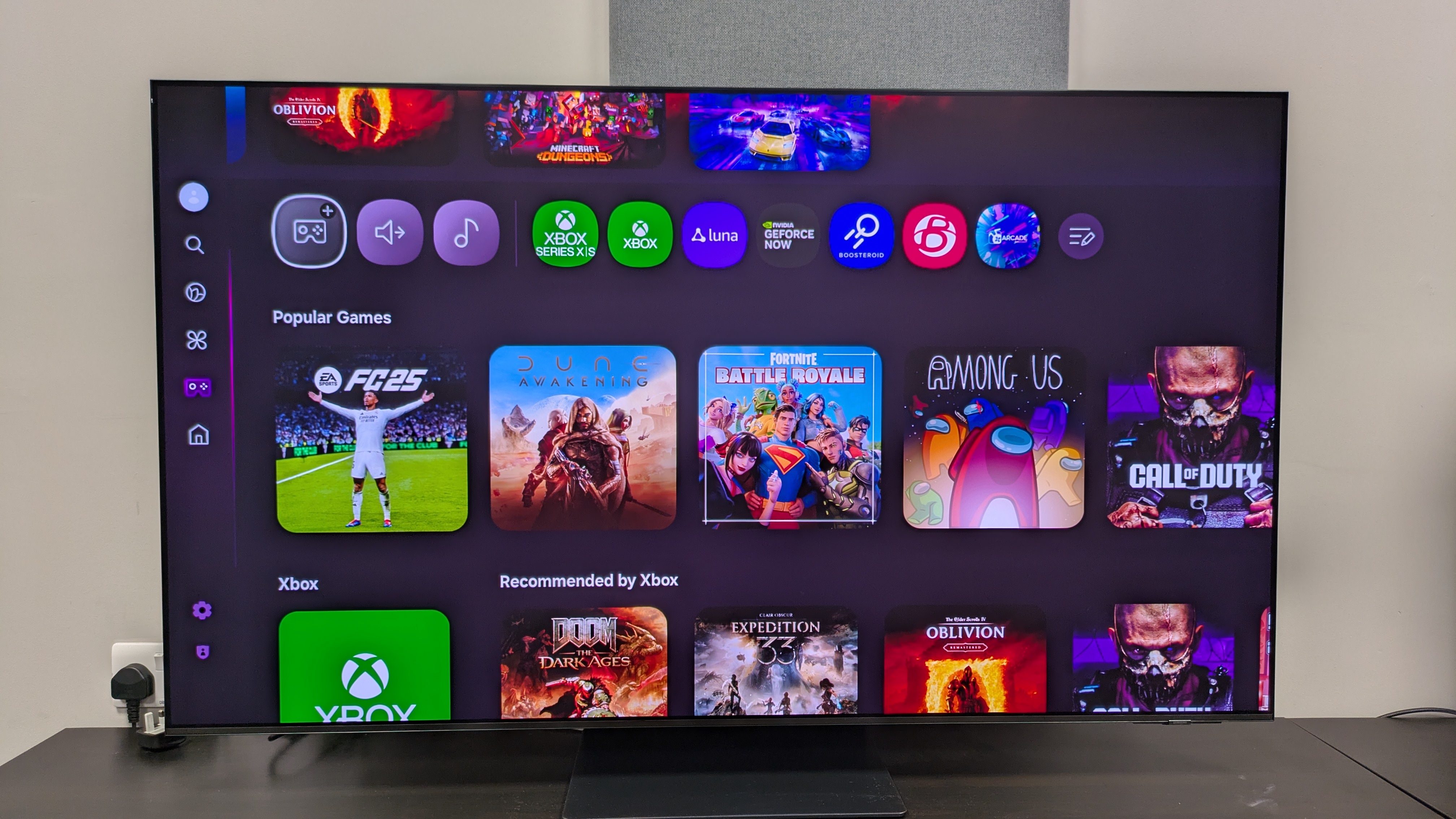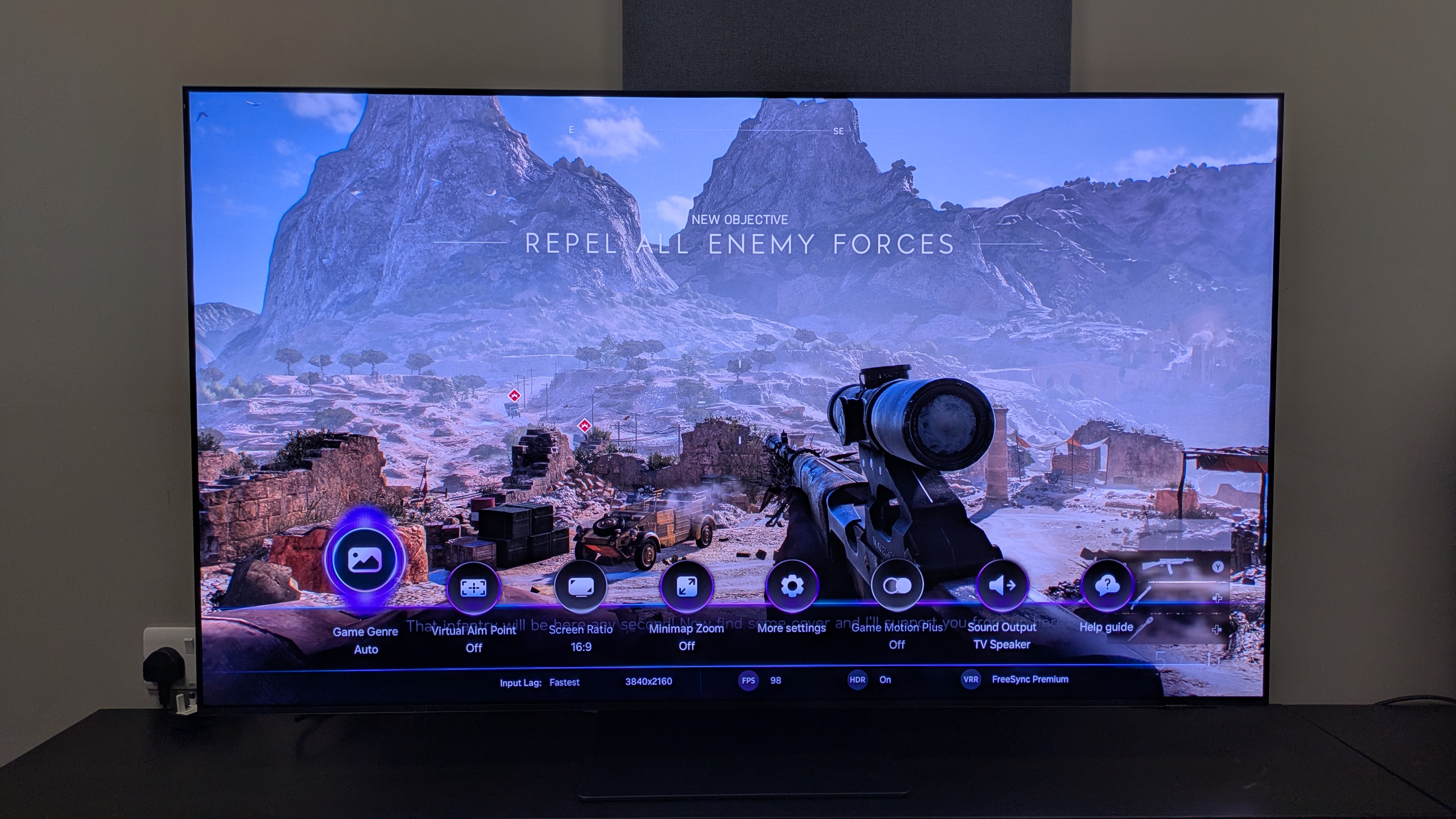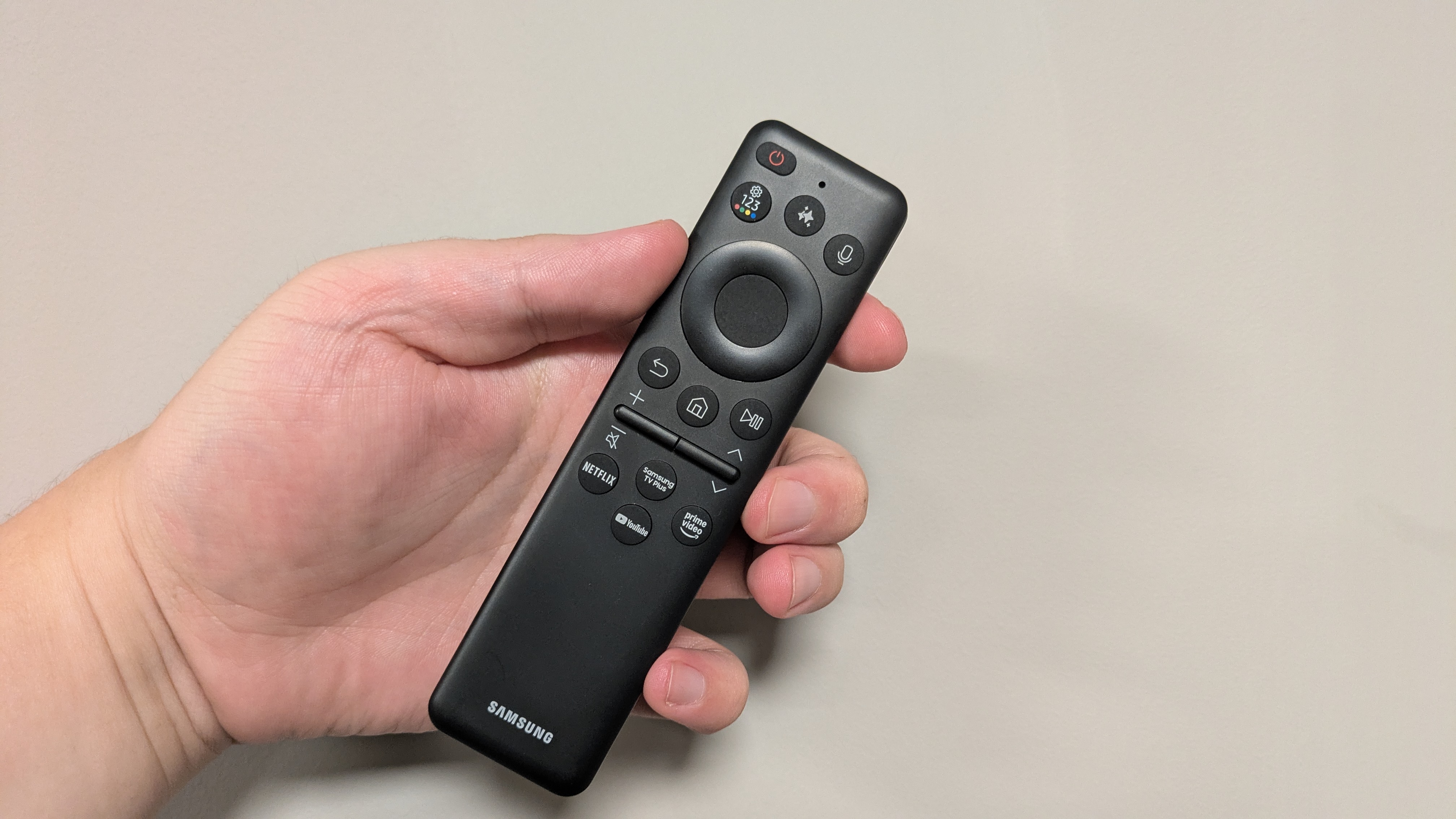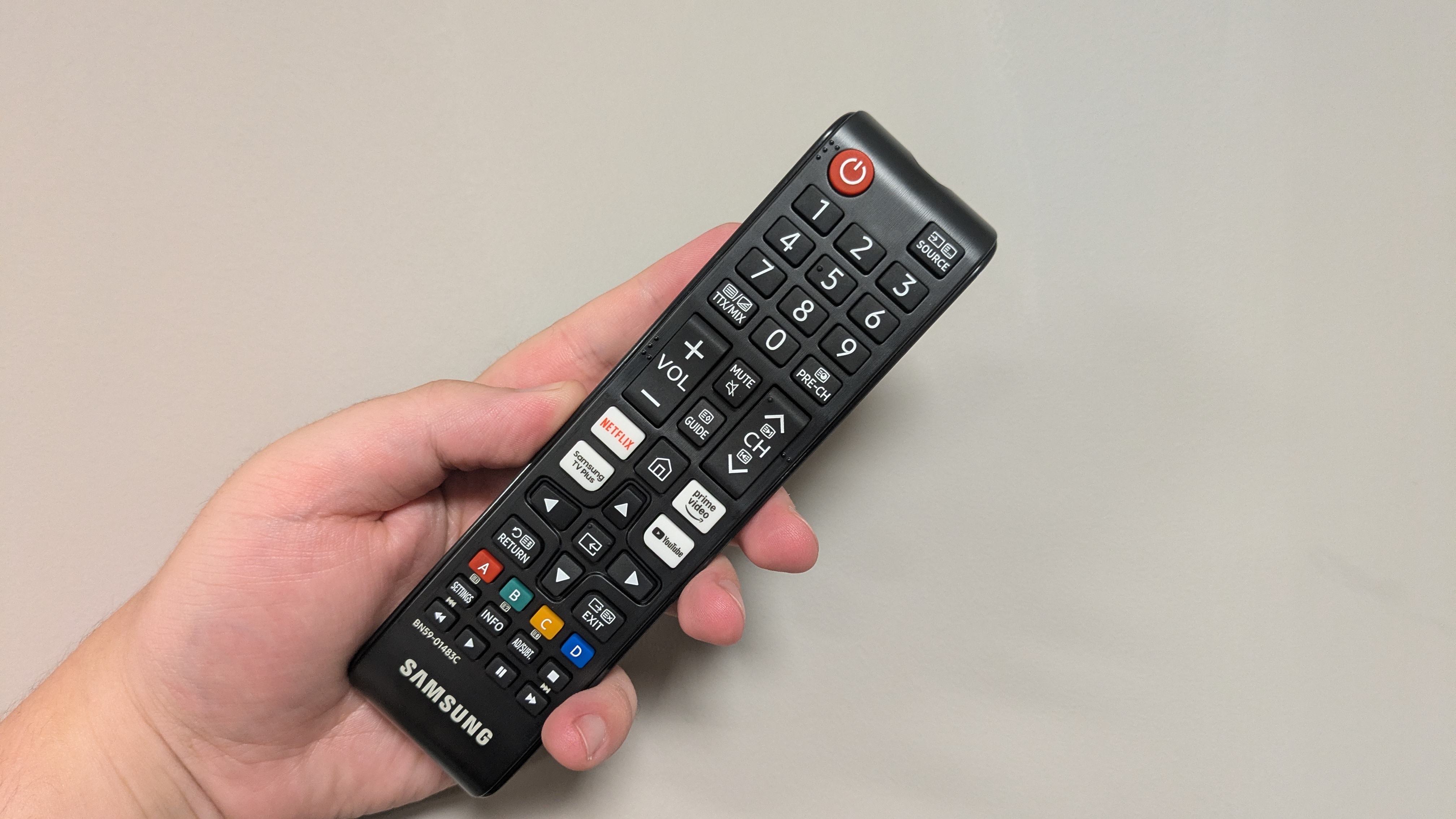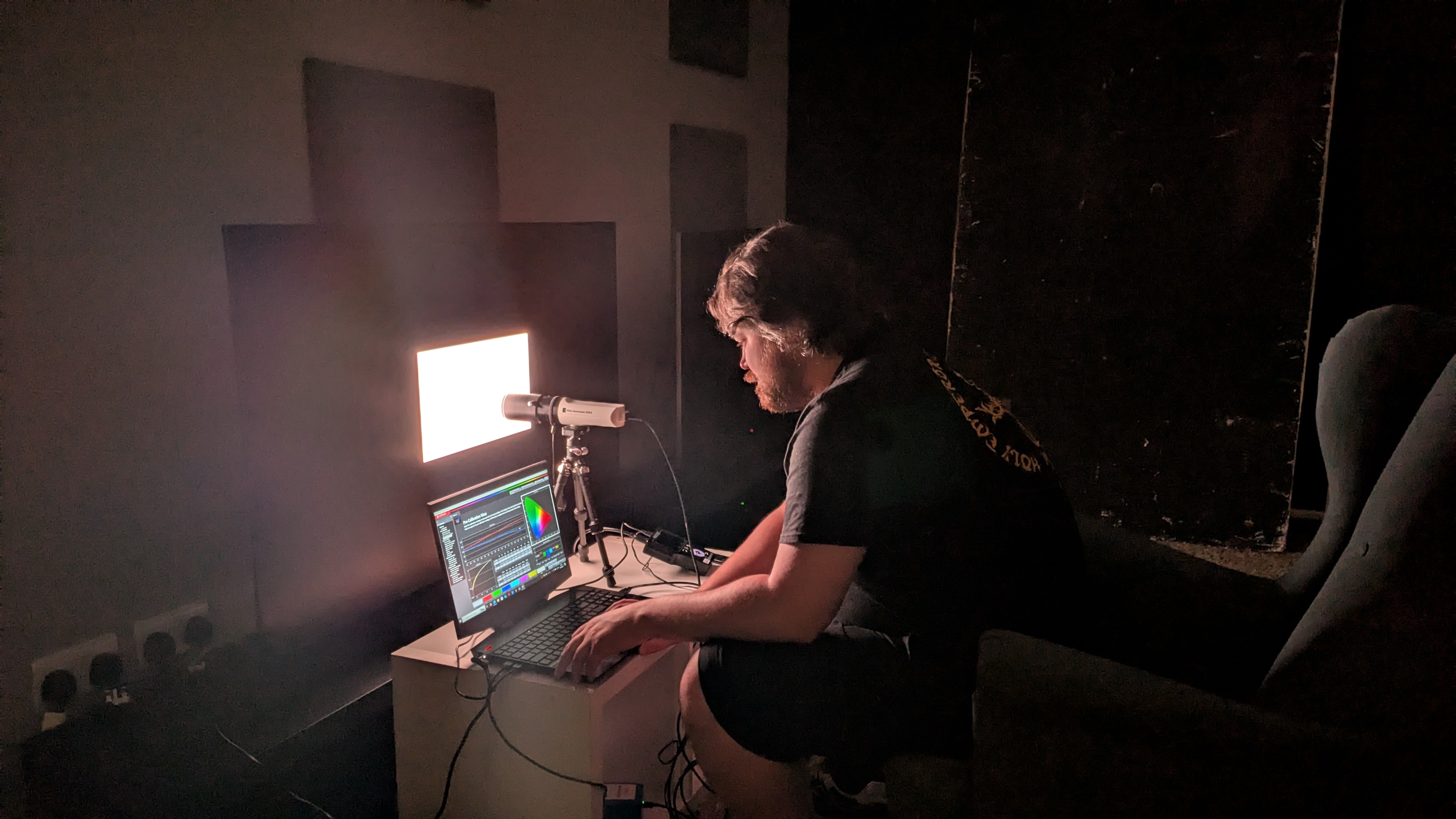Why you can trust TechRadar
We spend hours testing every product or service we review, so you can be sure you’re buying the best. Find out more about how we test.
Samsung S95F: Two minute review
The Samsung S95F is the brand’s 2025 flagship OLED TV, delivering a premium set of features with the performance to match, pushing brightness levels for this kind of TV to some new highs.
The Samsung S95F boasts an impressive list of features, including a number of AI-based enhancement tools for picture, such as 4K Upscaling Pro and Real Depth Enhancer, and sound, such as AI Sound and Active Voice Amplifier Pro, as well as an AI assistant for live TV show analysis and recommendations.
Picture quality on the S95F is excellent overall. Delivering staggering brightness levels that produce punchy vibrant colors, as well as rich contrast, black levels and extremely realistic textures, the S95F is a sight to behold even compared to the best OLED TVs.
One thing to note here is that I reviewed the 55-inch version, which uses a new-gen QD-OLED screen, as does the 65-inch and 77-inch version, though the 83-inch size uses the same W-OLED new-gen panel as the LG G5. The benchmark measurements in this review are from the 55-inch model – I have also measured an 83-inch version, and included some information about that in the Picture Quality section, but those tests weren’t done in our usual testing areas, and the set was tested pre-release, so may not totally match what you’ll buy today, but I’ve included them for reference.
Its OLED Glare Free 2.0 screen delivers the same impressive reflection-beating performance as its predecessor, the Samsung S95D, but improves on black crush issues I found with the S95D. There is still some black crush present, and motion does require some tweaking to get to your own tastes, but the S95F still delivers picture quality that’s up there with the best TVs.
Built-in sound is punchy, accurate and delivers plenty of solid bass for such a thin TV, while also delivering clear speech and effective virtual surround sound. Atmos effects are still a little lacking and the soundstage can feel narrow at times, but most will be pleased with the S95F’s sound quality. Cinephiles: I’d still recommend one of the best soundbars.
The S95F is a physically stunning TV with a razor-thin, sharp and sleek design that gives it a premium look. Its One Connect Box, its external box for cable management and housing of ports, keeps things neat and tidy: excellent for those looking to wall-mount. Its stand requires a two person installation due to its weighty, metal design but it just makes the S95F feel that much more premium.
Tizen 9.0 is used as the smart TV platform for the S95F and it’s an improvement over previous generations. It’s smooth, mostly stutter-free and has plenty of picture settings, including AI ones, to tweak the picture to your liking. Recommendations are very good and although the home page can look a little cluttered and some settings are buried in menus, it’s definitely an upgrade over previous generations of Tizen.
The S95F is easily among one of the best gaming TVs of 2025. It supports 4K, 165Hz, VRR with AMD FreeSync Premium Pro, ALLM and HDR10+ gaming across four HDMI 2.1 ports, as well as boasting an ultra-low 9.5ms input lag time. Its Game Hub offers tons of cloud gaming options for those without a console and delivers razor-sharp performance and picture when gaming.
To get this premium performance, you have to pay a premium price. The S95F is similarly priced to its closest rivals, namely the LG G5, and while the price may be a bit lofty for some at launch, there will no doubt be discounts throughout its life cycle. For now though, it still mostly justifies its high price tag.
Should you buy this or the LG G5, which we also gave five stars to? I think the LG G5 just has the edge in most cases, thanks to its Dolby Vision support and the way it keeps black tones as dark and accurate as possible in more conditions. I think the Samsung is the better choice in really bright rooms where you know reflections are a challenge, or for aesthetes who love the idea of the One Connect box keeping cable clutter out of the way.
Samsung S95F review: Prices & release date
- Release date: May 2025
- 55-inch: $2,499 / £2,499 / N/A
- 65-inch: $3,399 / £3,399 / AU$5,295
- 77-inch: $4,499 / £4,299 / AU$7,995
- 83-inch: $6,499 / £6,799 / AU$9,995
The Samsung S95F is the brand’s 2025 flagship OLED TV, sitting above the mid-range Samsung S90F and the entry-level Samsung S85F in its OLED TV lineup. The 55-inch model I tested launched at a price of $2,499 / £2,499, with the popular 65-inch model available for $3,399 / £3,399 / AU$5,295.
Several weeks on from launch, prices remain largely unchanged, although we’ve seen a $200 / £200 discount on the 55-inch model and sometimes the 65-inch model. There’s sure to be more price drops throughout the year, as is normal for TVs.
Samsung S95F review: Specs
|
Screen type |
QD-OLED |
|
Refresh rate |
Up to 165Hz |
|
HDR support |
HDR10+, HDR10, HLG |
|
Audio support |
Dolby Atmos |
|
Smart TV |
Tizen |
|
HDMI ports |
4 x HDMI 2.1 |
|
Built-in tuner |
ATSC 3.0 (US) |
Samsung S95F review: Benchmark results
Samsung S95F review: Features
- Glare Free 2.0 matte screen
- NQ4 AI Gen 3 processor with AI tools
- One Connect box for external connections
The Samsung S95F uses a QD-OLED panel in its 55, 65 and 77-inch models, but the largest 83-inch model uses the new Primary Tandem RGB, or ‘four-stack’, OLED panel: the same used in the LG G5.
The S95F comes with the OLED Glare Free 2.0 screen: an updated version of the anti-reflection, matte screen found in its predecessor, the Samsung S95D.
It’s equipped with the NQ4 AI Gen 3 processor, which offers AI based enhancements such as Real Depth Enhancer, 4K AI Upscaling Pro, Auto HDR Remastering Pro, Color Booster Pro and AI Motion Enhancer Pro. There are also AI Customization settings for both picture and sound which can be tweaked.
As always, the S95F supports HDR10+, HDR10 and HLG HDR formats, but there is no support for Dolby Vision. It also supports Dolby Atmos enhanced sound format, but there is no support for DTS.
For audio, the S95F comes with a built-in 4.2.2 channel speaker array, totaling 70W of power. It has the Object Tracking Sound+ (OTS+) system for more accurate sound mapping as well as AI Sound mode with voice enhancement. It also supports Samsung’s Q-Symphony feature, where the TV can be used in tandem with compatible Samsung soundbars as an extra speaker.
The S95F is also a well equipped gaming TV, with four HDMI 2.1 ports that support 4K, 165Hz, VRR (AMD FreeSync Premium Pro included), ALLM and HDR10+ gaming. Its Game Hub is a useful portal for housing all things gaming, including cloud based gaming apps from Xbox, Luna, Nvidia GeForce Now and more.
In terms of physical features, the S95F’s most significant addition is the One Connect Box, an external box designed to house all connections such as HDMI and USB, connected to the TV by a single cable that carries power as well as video. For US viewers, the S95F carries an ATSC 3.0 tuner.
The S95F uses Samsung’s Tizen as its smart TV platform and has access to all major streaming apps such as Netflix, Prime Video and Disney Plus, as well as UK based apps such as ITVX and BBC iPlayer. Tizen has several hubs to house relevant apps including Home, the aforementioned Game, Ambient and Daily+.
Samsung S95F review: Picture quality
- Spectacular color and brightness
- Very effective anti-reflection screen
- Improved black levels over the S95D
Starting with my measurements of the 55-inch S95F’s performance using out-of-the-box settings, the TV hit 2,132 nits of HDR peak brightness (measured on a 10% HDR white window pattern) in Filmmaker Mode. When I measured a pre-release version of the 83-inch model at a Samsung event, which has a different type of OLED screen (the same as the LG G5), I measured 2,388 nits of peak HDR brightness in Filmmaker Mode on that model, which is a good 10% step up over the smaller option.
The LG G5, for comparison, measured 2,268 nits in HDR peak brightness in Filmmaker Mode, so sits closer to the 83-inch version of the S95F, which makes sense.
The 55-inch S95F achieved 2,135 nits of peak HDR brightness in Standard mode, while the 83-inch version hit 2,102 nits in the same test. The LG G5 hit 1,850 nits in Standard Mode, so the S95F has a clear edge over its rival in that kind of mode.
I also measured the 55-inch S95F’s Movie mode brightness, as I found myself using this mode with some movies in brighter conditions, and it hit 2,109 nits of peak HDR brightness.
As for HDR fullscreen brightness, important for sports, daytime and bright room viewing, the 55-inch S95F clocked 390 nits in Filmmaker Mode (measured on a 100% white HDR window pattern), making it the brightest 55-inch OLED we’ve tested. It beat the previous champion, the LG G5, which clocked in 331 nits in its Filmmaker Mode.
However, the the 83-inch version of the S95F I tested crushed its smaller sibling, achieving 465 nits of fullscreen brightness in Filmmaker Mode – a figure you expect from the best mini-LED TVs.
With SDR fullscreen brightness however, the LG G5 still holds the crown, hitting 327 nits in Filmmaker Mode, whereas the S95F clocked in at 181 nits.
The S95F’s most unusual feature is its OLED Glare Free 2.0 screen, which like its predecessor, the S95D, eliminated mirror-like reflections even with bright overhead lights on in our testing room.
The issue with mirror-like reflections is that they’re actually on a different focal plane to the TV, so when your eye catches them, you have to focus away from the rest of the screen. That’s why they’re so annoying, and are quite fatiguing to deal with. On the S95F they’re reduced to just a haze at most.
I found when I tested the S95D that the matte screen caused black crush, particularly in Filmmaker Mode, so you lost detail in the dark areas OLED is supposed to excel in – and thankfully the S95F has improved this. There were still some instances of black crush in dark scenes in movies like The Batman and Nosferatu, but they were minimal in comparison.
I did find when watching dark movies in bright rooms, setting Dynamic Tone Mapping from the default Static to Active in Filmmaker Mode gave it a solid brightness boost without sacrificing black levels or contrast too much, and helped to reduce the black crush.
Where the S95F really shines with its picture is its colors. Watching a 4K stream of Elemental on Disney Plus, fire characters – as well as Ember’s glass and vase-making – deliver stunning, glistening reds and oranges with a real vivid punch in highlight areas of the screen.
A 4K Blu-ray of Wicked also demonstrated natural but vibrant colors, particularly in the Wizard & I scene where Elphaba stands among pink flowers. I preferred Filmmaker Mode’s accuracy, but those looking for a brighter dose of color can select Movie mode for something that’s bold but still realistic.
It’s no surprise the 55-inch S95F delivered such spectacular HDR colors, because when I measured its HDR color gamut coverage, it yielded results of 100% and 89.3% in the DCI-P3 and BT.2020 color spaces. These are not only phenomenal results, but it’s also the first time a TV has hit 100% DCI-P3 in my time testing TVs. I measured the 83-inch S95F at 94.9% of P3 color gamut coverage, however – this is surprisingly low, considering the LG G5 with the same panel achieved 99.6%, so it might be best to take it with a pinch of salt, since I tested it pre-release.
Black levels and contrast are still excellent on the S95F, particularly when viewed in dimmed or pitch black conditions. Watching The Batman, the subway fight and crime scene sequences showed deep black levels with brilliant contrast between dark areas and light areas from light sources such as lamps, torches and flashbulbs. Shadow detail was great as well, with objects on walls still visible even in dark sections.
The S95F was great for black and white movies, as scenes from Oppenheimer showed deep black tones, vibrant white tones and a full range of gray tones with fantastic depth and texture.
Speaking of textures, the S95F showed a near 3D-like quality for every 4K movie I used. Clearly, the Real Depth Enhancer was hard at work, as every facial feature, skin tone and object looked accurate, lifelike and refined. I found the S95F’s upscaling was effective when viewing an HD stream of Fight Club. While not as successful with lower resolution TV shows, textures were definitely still upscaled.
Motion for the S95F was responsive, though I did find that Blur and Judder reduction needed to be set at 5 each, though this may require some adjusting for some. A panning shot of a cliffside in No Time To Die was smooth without the dreaded soap opera effect with these settings. For Sports, I opted for Standard Mode with these settings and found the action smooth without any ghosting of the ball during a stream of a soccer game.
The S95F is an overall fantastic TV, but I put it side-by-side with the LG G5 and while the S95F was better for bright room viewing, I couldn’t help but admire the G5’s richer, inkier black levels. It did make the S95F’s black levels look gray in bright conditions by comparison. The matte screen obviously is a compromise, but thankfully some tweaking of the S95F’s settings mentioned above can narrow the gap. It’s even better if you can view in dimmed conditions.
- Picture quality score: 5/5
Samsung S95F: Sound quality
- 4.2.2 channel, 70W speaker array
- Object Tracking Sound+ (OTS+) for accurate mapping
- Dolby Atmos, but no DTS support
The Samsung S95F comes equipped with a built-in 4.2.2 channel speaker array, with 70W of total power. It includes AI Sound mode options and supports Dolby Atmos soundtracks. There is no support for DTS soundtracks, however. There are two preset sound modes to choose from: Standard and Amplify.
With the S95F set to the Amplify sound mode, the Batmobile/Penguin chase scene in The Batman produced hefty, impactful bass and rumble from the Batmobile’s engine and explosions. The OTS+ system was effective at mapping effects such as screeching tyres and gunfire and keeping the action on screen and sound tightly connected and controlled.
Throughout Wicked, the S95F’s speakers also delivered clear vocals and speech as well as a very good balance between said vocals and the uplifting and powerful score, which was itself delivered with clarity and precision.
While its built-in sound is very good, I couldn’t help but find the soundstage narrow in places and that its volume needed to be pushed to get the full experience. When pushed too high however, there can be some buzz from the bass. For a proper cinematic experience, one of the best Dolby Atmos soundbars remains recommended.
Samsung S95F review: Design
- Super slim, modern design
- One Connect Box for external connections
- Solid, sleek metal base
The S95F is a sight to behold. Razor-thin with a bezel-less screen, the S95F is incredibly sleek and has an appealing modern look. It comes with a weighty, black metal stand and while assembly requires two people, once attached it gives the TV a floating look and feels solid and sturdy.
The S95F comes with the brand’s One Connect Box, which houses the S95F’s many connections, including four HDMI 2.1 ports, three USB ports, an optical port, tuner ports for broadcast TV and an Ethernet port. This box is then connected to the S95F via a single cable and the box itself can be housed on the back of the stand. It’s ideal for those looking to wall-mount their TV with minimal cables.
For remotes, the S95F comes with the SolarCell remote, a small remote with volume control, app shortcuts and the new AI button, for AI assistant shortcuts. The remote can be charged via USB-C or the solar panel on the remote. UK users will also find an older-style remote with numbered buttons in the box as well as the SolarCell remote.
Samsung S95F review: Smart TV & menus
- Tizen smart TV platform
- Home, Game, Ambient and Daily+ hubs for apps
- Good number of picture settings
The S95F uses Samsung’s own Tizen smart TV platform, with this year’s version called Tizen 9.0. It has access to all the major streaming apps, but UK users should note it does not include Freeview Play for broadcast TV, instead using Samsung’s own Samsung TV Plus. UK based streaming apps are still available however.
Tizen 9.0’s home page is split into three sections: For You, which houses AI-tailored content recommendations (which are mostly accurate and effective based on my own experience) Live, for live TV and Apps, for a fuller apps page list. For You is the default and while there is a large banner at the top of the screen, a neat, customizable row of apps sits at the bottom of the screen and is easily accessible.
Aside from the Home page, there are three other main hubs: Game for gaming based applications; Ambient, for an ambient mode in place of standby; and Daily+ for lifestyle and workplace based apps.
Menu and settings navigation is made easier thanks to a quick menu, which I didn’t find as effective as LG’s but is still a welcome addition. Accessing the right menus and settings can be long-winded and navigation can stutter on occasion, but it was a mostly smooth experience.
As well as the usual picture and sound settings, of which there are a good amount for picture customization, there are a number of AI-based tools including AI picture and sound modes. There is an AI assistant as well. A press of the remote’s AI button on a TV show on Samsung TV Plus gave me a summary of the show and recommended similar shows.
Samsung S95F review: Gaming
- 4K, 165Hz, VRR, ALLM and HDR10+ gaming
- Ultra-low 9.5ms input lag time
- Game Hub for cloud based gaming apps
The S95F is an extremely well featured TV for gaming. It features four HDMI ports that support 4K, 165Hz, VRR with AMD FreeSync Premium Pro supported, ALLM and HDR10+ gaming. Samsung’s Game Hub continues to be an excellent portal for everything gaming related including a healthy choice of cloud based gaming apps from the likes of Xbox, Nvidia GeForce Now and Luna.
As with Samsung’s TVs, the S95F is no slouch with gaming performance either. An ultra-low 9.5ms input lag time delivers a smooth experience with no hint of screen tear or stutter in performance whatsoever. Playing Battlefield V, intense combat sequences were exciting to play and targeting was easy, snappy and extremely responsive.
The S95F also delivers superb picture quality for gaming, with several levels in Battlefield V given a truly bright, vibrant and dynamic look filled with color and detail. Again Real Depth Enhancer Pro gave the picture a hyper-realistic look with fantastic detail in every object on screen.
Samsung S95F review: Value
- Performance and features justify price
- Closely priced with rivals
- Still a premium priced TV
Value is a tough area to judge for the Samsung S95F, as it carries most of the features you’d ever need while also delivering high-quality performance, but this all comes at a premium price.
The 55-inch model I tested costs $2,299.99 / £2,299 (roughly AU$3,554) at the time of writing. The S95F’s main rival, the LG G5, 55-inch model costs $2,199.99 / £2,199.99 / AU$3,495 at the time of writing, making the G5 the more tempting of the two. Expect prices to battle throughout the year, reducing over time.
I’d usually recommend the S95F’s step-down sibling – the S90F – as a cheaper alternative, because the 55-inch model there costs $1,799 / £1,899 / AU$3,299. However, there is no guarantee of getting a bright QD-OLED screen over a dimmer mid-tier W-OLED screen, which means I can’t recommend it for certain. At 65 inches, you are guaranteed a QD-OLED panel, though, so at that size the S90F is a great option – here’s our full 65-inch Samsung S90F review.
The S95F is a premium priced TV, there’s no getting around it. While there are a number of cheaper options available, it does deliver an undoubtedly premium experience and does strongly justify its price.
Should you buy the Samsung S95F OLED TV?
|
Attributes |
Notes |
Rating |
|---|---|---|
|
Features |
The Samsung S95F offers a stacked list of smart and gaming features, along with superb picture quality and solid audio quality. There is still no Dolby Vision HDR support though. |
5/5 |
|
Picture quality |
The S95F delivers a near-complete picture experience, especially when with colors. Black levels may not be as deep as some rivals, but they’re rich enough. |
5/5 |
|
Sound quality |
Delivering clear, punchy and accurate sound, most people will be pleased with the S95F’s sound. Bass could be better controlled and the soundstage could be wider, however. |
4/5 |
|
Design |
It’s unbelievably thin, extremely modern looking and features the useful One Connect Box. the S95F is easily one of the best designed TVs available. |
4.5/5 |
|
Smart TV and menus |
Finding the right settings isn’t always easy, but Tizen provides a very smooth experience with new AI tools should you want to use them. |
4.5/5 |
|
Gaming |
Ultra-responsive performance and a full list of features, the S95F is an excellent TV for gaming. |
5/5 |
|
Value |
The S95F is a premium priced TV, but offers great features and performance for the money. |
4/5 |
Buy it if…
Don’t buy it if…
Also Consider
| Header Cell – Column 0 |
Samsung S95F |
LG G5 |
Sony Bravia 8 II |
Samsung QN90F |
|---|---|---|---|---|
|
Price (55-inch) |
$2,499 / £2,499 (roughly AU$4,199) |
$2,499 / £2,399 / AU$4,199 |
$3,499 / £2,499 / AU$4,195 |
$1,799.99 / £1,699 (roughly AU$2,788) |
|
Screen type |
QD-OLED |
OLED |
QD-OLED |
Neo QLED / mini-LED |
|
Refresh rate |
165Hz |
144Hz |
120Hz |
144Hz |
|
HDR support |
HDR10+/HDR10/HLG |
HDR10, HLG, Dolby Vision |
HDR10, HLG, Dolby Vision |
HDR10, HLG, HDR10+, |
|
Smart TV |
Tizen 9.0 |
webOS 25 |
Google TV |
Tizen |
|
HDMI ports |
4x HDMI 2.1 |
4x HDMI 2.1 |
4 (2x HDMI 2.1) |
4 x HDMI 2.1 |
How I tested the Samsung S95F OLED TV
- Tested over a week
- Tested in different lighting conditions in our testing lab
- Measurements taken using Portrait Displays’ Calman color calibration software
Before my critical testing, I first spent time establishing the most accurate picture modes that I would use for both subjective testing and objective measurements. I landed on Filmmaker Mode and sometimes used Movie mode, depending on lighting conditions.
I tested the S95F’s using reference scenes from both Standard Dynamic Range (SDR) sources, such as DVD, Blu-ray and broadcast/low-resolution TV, and High Dynamic Range (HDR) sources, such as 4K Blu-ray and 4K streaming.
For 4K Blu-ray, I used a Panasonic DP-UB820 4K Blu-ray player, our pick for the best 4K Blu-ray player.
I used these sources to analyse the S95F’s picture quality, focusing on color, contrast, black levels, textures, upscaling, as well as sound quality and motion for sports and movies.
I also watched the S95F with various different lighting conditions to test the effectiveness of its OLED Glare Free anti-reflection screen.
For objective measurements, I used a Klein K10A colorimeter, Murideo Six G 8K test pattern generator and recorded measurements using Portrait Displays’ Calman color calibration software.
I focused on SDR and HDR brightness measurements, with a focus on peak (10%) and fullscreen (100%) brightness, color and grayscale accuray by taking the average of the Delta-E values (the margin for error between the source pattern signal and what’s shown on screen) and HDR color gamut coverage, focusing on DCI-P3 (also called UHDA-P3) and BT.2020 color spaces.
I also analyzed the S95F’s gaming performance using an Xbox Series X, and a Leo Bodnar 4K HDMI Input Lag Tester to analyze its input lag in milliseconds.
For more on how we test TVs at TechRadar, check out the link.
Read the full article here


